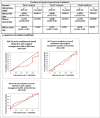Prevalence of acute post-operative pain in patients in adult age-group undergoing inpatient abdominal surgery and correlation of intensity of pain and satisfaction with analgesic management: A cross-sectional single institute-based study
- PMID: 27761037
- PMCID: PMC5064698
- DOI: 10.4103/0019-5049.191686
Prevalence of acute post-operative pain in patients in adult age-group undergoing inpatient abdominal surgery and correlation of intensity of pain and satisfaction with analgesic management: A cross-sectional single institute-based study
Abstract
Background and aims: Considering the paucity of regional data, this study was designed to investigate the prevalence of post-operative pain and determine if there exists any correlation between the intensity of post-operative pain and patient's level of satisfaction with their pain management after inpatient abdominal surgery at an academic tertiary care government centre.
Methods: Pain intensity was measured in 120 patients with numeric rating scale at the fifth post-operative hour, second and third post-operative day. A questionnaire was used to measure the level of satisfaction with nurse's and doctor's response to their pain and overall pain management.
Results: The prevalence of post-operative pain was 84.17%, 92.5% and 96.66% at the fifth post-operative hour, second and third post-operative day, respectively. Less number of patients experienced severe intensity pain on the third post-operative day (P = 0.00046), whereas the number of patients experiencing mild pain increased (P < 0.000) compared to the fifth post-operative hour. The number of patients with complete analgesia decreased on the third post-operative day (P = 0.001 compared to fifth post-operative day). The Spearman correlation coefficient between pain score on the third post-operative day and level of satisfaction with nurse's response, doctor's response to pain and the overall pain management was - 0.0218 (P = 0.8107), 0.1307 (P = 0.1553) and 0.0743 (P = 0.4195), respectively.
Conclusion: There is a high prevalence of acute post-operative pain in patients undergoing inpatient abdominal surgery at our institute. There is a weak correlation between the intensity of pain and level of satisfaction with pain management.
Keywords: Numeric rating scale; pain; patient satisfaction; post-operative.
Figures
References
-
- Couceiro TC, Valença MM, Lima LC, de Menezes TC, Raposo MC. Prevalence and influence of gender, age, and type of surgery on postoperative pain. Rev Bras Anestesiol. 2009;59:314–20. - PubMed
-
- Hanna MN, González-Fernández M, Barrett AD, Williams KA, Pronovost P. Does patient perception of pain control affect patient satisfaction across surgical units in a tertiary teaching hospital? Am J Med Qual. 2012;27:411–6. - PubMed
LinkOut - more resources
Full Text Sources
Other Literature Sources
Medical



